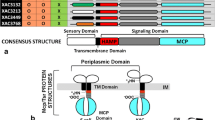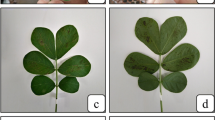Abstract
Xanthan-deficient mutants of Xanthomonas axonopodis pv. citri, the bacterium responsible for citrus canker, were generated by deletion and marker exchange of the region encoding the carboxy-terminal end of the first glycosyltransferase, GumD. Mutants of gumD did not produce xanthan and remained pathogenic in citrus plants to the same extent as wild-type bacteria. The kinetics of appearance of initial symptoms, areas of plant material affected, and growth of bacteria inside plant tissue throughout the disease process were similar for both wild-type and mutant inoculations. Moreover, exopolysaccharide deficiency did not impair the ability of the bacteria to induce hypersensitive response on non-host plants. Apart from variations in phenotypic aspects, no differences in growth or survival under different stress conditions were observed between the xanthan-deficient mutant and wild-type bacteria. However, gumD mutants displayed impaired survival under oxidative stress during stationary phase as well as impaired epiphytic survival on citrus leaves. Our results suggest that xanthan does not play an essential role in citrus canker at the initial stages of infection or in the incompatible interactions between X. axonopodis pv. citri and non-host plants, but facilitates the maintenance of bacteria on the host plant, possibly improving the efficiency of colonization of distant tissue.





Similar content being viewed by others
References
Astua-Monge G, Freitas-Astua J, Bacocina G, Roncoletta J, Carvalho SA, Machado MA (2005) Expression profiling of virulence and pathogenicity genes of Xanthomonas axonopodis pv. citri. J Bacteriol 187:1201–1205
Becker A, Katzen F, Puhler A, Ielpi L (1998) Xanthan gum biosynthesis and application: a biochemical/genetic perspective. Appl Microbiol Biotechnol 50:145–152
Bellemann P, Geider K (1992) Localization of transposon insertions in pathogenicity mutants of Erwinia amylovora and their biochemical characterization. J Gen Microbiol 138:931–940
Brunings AM, Gabriel DW (2003) Xanthomonas citri: breaking de surface. Mol Plant Pathol 4:141–157
Chou FL, Chou HC, Lin YS, Yang BY, Lin NT, Weng SF, Tseng YH (1997) The Xanthomonas campestris gumD gene required for synthesis of xanthan gum is involved in normal pigmentation and virulence in causing black rot. Biochem Biophys Res Commun 233:265–269
da Silva AC, Ferro JA, Reinach FC, Farah CS, Furlan LR, Quaggio RB, Monteiro-Vitorello CB, Van Sluys MA, Almeida NF, Alves LM, et al. (2002) Comparison of the genomes of two Xanthomonas pathogens with differing host specificities. Nature 417:459–463
Denny TP (1999) Autoregulator-dependent control of extracellular polysaccharide production in phytopathogenic bacteria. Eur J Plant Pathol 105:417–430
Dharmapuri S, Sonti RV (1999) A transposon insertion in the gumG homologue of Xanthomonas oryzae pv. oryzae causes loss of extracellular polysaccharide production and virulence. FEMS Microbiol Lett 179:53–59
Dolph PJ, Majerczak DR, Coplin DL (1988) Characterization of a gene cluster for exopolysaccharide biosynthesis and virulence in Erwinia stewartii. J Bacteriol 170:865–871
Dow JM, Crossman L, Findlay K, He YQ, Feng JX, Tang JL (2003) Biofilm dispersal in Xanthomonas campestris is controlled by cell–cell signaling and is required for full virulence to plants. Proc Natl Acad Sci USA 100:10995–11000
Dow JM, Feng JX, Barber CE, Tang JL, Daniels MJ (2000) Novel genes involved in the regulation of pathogenicity factor production within the rpf gene cluster of Xanthomonas campestris. Microbiology 146:885–891
Dunger G, Arabolaza LN, Gottig N, Orellano EG, Ottado J (2005) Participation of Xanthomonas axonopodis pv. citri hrp cluster in citrus canker and in non-host plants responses. Plant Pathol 54:781–788
Graham JH, Gottwald TR, Cubero J, Achor DS (2004) Xanthomonas axonopodis pv. citri: factors affecting successful eradication of citrus canker. Mol Plant Pathol 5:1–15
Harding NE, Cleary JM, Ielpi L (1995) Genetics and biochemistry of xanthan gum production by Xanthomonas campestris. In: Hui YH, Khachatourians G (eds) Food biotechnology microorganisms. VCH Publishers, New York, pp 495–514
Ielpi L, Couso RO, Dankert MA (1993) Sequential assembly and polymerization of the polyprenol-linked pentasaccharide repeating unit of the xanthan polysaccharide in Xanthomonas campestris. J Bacteriol 175:2490–2500
Jansson PE, Kenne L, Lindberg B (1975) Structure of extracellular polysaccharide from Xanthomonas campestris Carbohydr Res 45:275–282
Kang Y, Saile E, Schell MA, Denny TP (1999) Quantitative immunofluorescence of regulated eps gene expression in single cells of Ralstonia solanacearum. Appl Environ Microbiol 65:2356–2362
Kao CC, Barlow E, Sequeira L (1992) Extracellular polysaccharide is required for wild-type virulence of Pseudomonas solanacearum. J Bacteriol 174:1068–1071
Katzen F, Becker A, Zorreguieta A, Puhler A, Ielpi L (1996) Promoter analysis of the Xanthomonas campestris pv. campestris gum operon directing biosynthesis of the xanthan polysaccharide. J Bacteriol 178:4313–4318
Katzen F, Ferreiro D, Oddo C, Ielmini MV, Becker A, Puhler A, Ielpi L (1998) Xanthomonas campestris pv. campestris gum mutants: effects on xanthan biosynthesis and plant virulence. J Bacteriol 180:1607–1617
Katzen F, Becker A, Ielmini MV, Oddo CG, Ielpi L (1999) New mobilizable vectors suitable for gene replacement in Gram negative bacteria and their use in mapping of the 3′ end of the Xanthomonas campestris pv. campestris gum operon. Appl Environ Microbiol 65:278–282
Keen NT (1990) Gene-for-gene complementary in plant–pathogen interactions. Annu Rev Genet 24:447–463
Kemp BP, Horne J, Bryant A, Cooper RM (2004) Xanthomonas axonopodis pv. manihotis gumD gene is essential for EPS production and pathogenicity and enhances epiphytic survival on cassava (Manihot esculenta). Physiol Mol Plant Pathol 64:209–218
Kiraly Z, El Zahaby HM, Klement Z (1997) Role of extracellular polysaccharide (EPS) slime of plant pathogenic bacteria in protecting cells to reactive oxygen species. J Phytopathol 145:59–68
Koch E, Slusarenko A (1990) Arabidopsis is susceptible to infection by a downy mildew fungus. Plant Cell 2:437–445
Murray MG, Thompson WF (1980) Rapid isolation of high molecular weight plant DNA. Nucleic Acids Res 8:4321–4325
Mysore KS, Ryu C-M (2004) Non host resistance: how much do we know? Trends Plant Sci 9:97–104
Poplawsky AR, Chun W (1998) Xanthomonas campestris pv. campestris requires a functional pigB for epiphytic survival and host infection. Mol Plant–Microbe Interact 11:466–475
Reece KS, Phillips GJ (1995) New plasmids carrying antibiotic-resistance cassettes. Gene 165:141–142
Sambrook J, Fritsch EF, Maniatis T (1989) Molecular cloning. A laboratory manual, 2nd edn. Cold Spring Harbor Laboratory Press, Cold Spring Harbor
Slater H, Alvarez-Morales A, Barber CE, Daniels MJ, Dow JM (2000) A two-component system involving an HD-GYP domain protein links cell–cell signalling to pathogenicity gene expression in Xanthomonas campestris. Mol Microbiol 38:986–1003
Sukchawalit R, Vattanaviboon P, Sallabhan R, Mongkolsuk S (1999) Construction and characterization of regulated l-arabinose-inducible broad host range expression vectors in Xanthomonas. FEMS Microbiol Lett 181:217–223
Tang J, Liu Y, Barber C, Dow J, Wooton J, Daniels MJ (1991) Genetic and molecular analysis of a cluster of rpf genes involved in positive regulation of synthesis of extracellular enzymes and polysaccharide in Xanthomonas campestris pathovar campestris. Mol Gen Genet 226:409–417
Thordal-Christensen H, Zhang Z, Wei Y, Collinge DB (1997) Subcellular localization of H2O2 in plants. H2O2 accumulation in papillae and hypersensitive response during the barley–powdery mildew interaction. Plant J 11:1187–1194
Vojnov AA, Slater H, Daniels MJ, Dow JM (2001) Expression of the gum operon directing xanthan biosynthesis in Xanthomonas campestris and its regulation in planta. Mol Plant–Microbe Interact 14:768–774
Yu J, Penaloza-Vazquez A, Chakrabarty AM, Bender CL (1999) Involvement of the exopolysaccharide alginate in the virulence and epiphytic fitness of Pseudomonas syringae pv. syringae. Mol Microbiol 33:712–720
Acknowledgments
This work was supported by grants from Argentine Federal Government (ANPCyT to E.G.O, J.O., and L.I.), Fundación Antorchas and CONICET (to J.O.), and University of Buenos Aires (to L.I.). G.D., M.L.T., and M.B. are recipients of doctoral fellowships from CONICET.
Author information
Authors and Affiliations
Corresponding author
Rights and permissions
About this article
Cite this article
Dunger, G., Relling, V.M., Tondo, M.L. et al. Xanthan is not essential for pathogenicity in citrus canker but contributes to Xanthomonas epiphytic survival. Arch Microbiol 188, 127–135 (2007). https://doi.org/10.1007/s00203-007-0227-8
Received:
Accepted:
Published:
Issue Date:
DOI: https://doi.org/10.1007/s00203-007-0227-8




